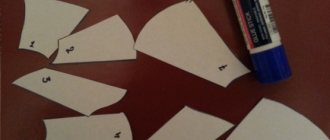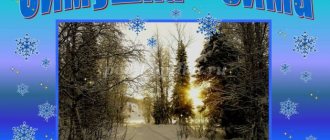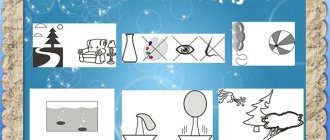Lesson summary for the preparatory group “Journey to the world of plants”
- December 26, 2018
International and All-Russian competitions
All-Russian competition of pedagogical excellence “Methodological piggy bank of a kindergarten teacher”
Plants are a fertile object for learning, for developing a child’s powers of observation and thinking. He sees many plants at any time of the year, he can touch, smell, taste them, etc.
And this diversity of plants appears to him not in a static, but in a constantly changing form. This activity teaches to appreciate and preserve the beauty of nature, strives to evoke a feeling of gratitude in children, and provides knowledge about trees and medicinal plants.
Topic: Journey into the world of plants
Program content:
- instill in children a culture of behavior in the forest, teach them to take care of everything that grows and lives there. Remind children of the various gifts that the forest gives to people;
- consolidate children's knowledge about trees and medicinal plants;
- teach to appreciate and preserve the beauty of nature using artistic words;
- strive to instill in children a feeling of gratitude that the world is beautiful.
Previous work: Looking at illustrations, reading books, getting acquainted with the “green pharmacy”, looking at plants, herbarium, excursion to the forest, park, pond.
Progress of the lesson
Educator: Once upon a time there was an Artist. He was an extraordinary artist. He could see the miracle in the ordinary. Miracles surround us everywhere: on the street, in the forest, by the sea. And the Artist went on an extraordinary journey - into the world of plants. This is the fairy-tale world of the good Tsar Berendey. Look closely and listen, and you will find yourself in the forest. (Sound melody).
The forest is full of mysteries and mysteries. To understand how the forest lives, why everything happens this way and not otherwise. You need to know the plant world well.
Trees grow in the forest. I can tell you where the word “tree” comes from. “Tear”, “tree”, “healthy” are related words. Does this surprise you? These words are connected to each other by the ancient word “deru”.
This word was in ancient Greek and Slavic languages and everywhere it meant “forest”, “tree”, “oak”, “resin” or “strength”, “power”, “endurance”.
Perhaps our distant ancestor, clearing a place for arable land, transferred the meaning of this word to the trees being uprooted.
Well, “healthy” simply means “strong as a piece of wood.” It turns out there are so many interesting things in the simple word “tree”. What types of trees are there? Let's tell each other riddles.
(Children make and guess riddles).
Standing in white clothes, dangling earrings. (Birch)
In a white sundress, she stood in a clearing, tits flew, sat on their braids. (Birch)
Educator: Birch is the only tree in the world with white bark. Here it is, the first miracle! And the tree got its name from the color of its bark.
Among the ancient Slavs, the word “Ber” meant “light”, “clear”, “brilliant”, “white”. From the word “Ber” we got the words “berza”, “birch”.
There is a special substance in the birch bark that colors the bark white; the trunk is always cool, it reflects the rays of the sun. Scientists named it betulin (the Latin word for birch is betula).
Furniture, skis, and tar are made from birch. Kidney infusions are a cure for colds and chafing of joints. Birch sap is obtained.
(Children read poems about birch).
Educator: What other riddles are there about trees?
He is of a heroic build, spreading and tall. Acorns grow on it. What's his name? (Oak)
This tree is not at all afraid of rain and wind. Who said that a tree is afraid of catching a cold? A mighty, strong hero with acorns. (Oak)
Educator: The ancient Slavs called the oak the greatest miracle, a beauty, a mighty, strong “Perun tree” in honor of the god of thunder and lightning. The most important god was Perun.
Oak wood is used in the construction of ships and carriages, and is used to make houses. Medicines are made from the bark to strengthen the intestines and cure a sore stomach.
(Children read poetry).
Next riddle
You will always find her in the forest - Let's go for a walk and meet her: Standing prickly like a hedgehog, In winter in a summer dress. (Spruce).
One color in winter and summer. (Spruce).
Educator: Spruce is an evergreen plant, eternal life and health are associated with it. Spruce is used to make paper, artificial silk, musical instruments, build wooden houses and make medicines.
Slender and beautiful, she wears a red berry (rowan)
In the spring I was green, In the summer I was sunbathing, In the autumn I wore Red corals (rowan)
Educator: Rowan berries contain a lot of vitamins (for people, birds and animals).
That's right, you have solved all the riddles.
Where do these trees grow? (In the forest).
What else can you find in the forest? (Children's answers).
That's right, a real forest consists of trees, herbs, mushrooms, flowers, animals and birds, as well as medicinal plants. What medicinal plants do you know? (Children's answers).
Coltsfoot .
Where do we get this name from? (from fairy tales)
Her family lived happily until her mother got sick and then died. The father married another woman. And immediately the songs and joyful games of the children died down in the house. People began to notice that life in the family seemed to stand still. The stepmother speaks warmly, but blows cold air, runs her hand through her hair - as if she is planting burrs.
As soon as the sun warmed up, the youngest daughter, out of melancholy, began to run up the slope to the river, crying tears.
One day I raised my head and a yellow flower blossomed at my feet. On that day, the stepmother disappeared forever, there was no trace. And a flower appears every spring.
He looks to see if the children are doing well and then disappears again. In its place, leaves grow in summer, cold on top and warm and soft below.
The leaves are collected in mid-summer (July), dried in the shade - a medicinal product, without petioles.
This plant, mother and stepmother, treats cough, heart, runny nose, heals wounds.
And in the spring, the early honey of the flowers themselves is sweet, the most healing, and helps out all the bees and bumblebees after a long winter.
Dandelion got its name because its seeds can fly: dandelion, wind blower, and wind blower.
The dandelion received heroic power from man. Once upon a time, in a land devastated by enemies, a peasant boy accidentally survived. In the dust and dirt, the only living thing he found was a broken dandelion flower. He straightened his hat, and he came to life. The clearing was soon covered with a carpet of yellow flowers.
People from other places came here and drove out the enemy. Since then, the most powerful of the field herbs - the dandelion - has been paying man for its strength.
Dandelion is edible: salad is made from young leaves, coffee is made from roots, jam and honey are made from flowers. They make medicine for toothache, eye diseases, and insomnia. The juice removes freckles. The roots are harvested in early spring or late autumn, washed, dried, and dried in the oven.
A decoction of the roots treats patients with jaundice.
(Poems about dandelion).
Wormwood
There is a story about two shepherds - rivals.
They lived in the same area. From dawn to dusk they grazed their cows. One day, one shepherd noticed that another shepherd’s cows were all well-fed and smooth, but his cows could barely drag their legs. Why is that? And he saw that the shepherd was keeping his flock in a wormwood meadow; at that time wormwood was not bitter. But such envy awoke in the unsuccessful shepherd that in a moment in the clearing the grass went rancid forever and became bitter.
Wormwood is a medicinal plant.
If a tired traveler ties wormwood to his leg, it will relieve fatigue.
Flowers and leaves, when added to food, are beneficial to the stomach and expel poison and bile from a person.
In Rus', wormwood juice was used to treat wounds and bruises. The housewife who will pickle cucumbers or cabbage must steam the barrel with a decoction of wormwood.
Insects, moths, fleas, and ticks are afraid of wormwood.
Wormwood is poisonous and must be handled with care.
Collect the tops of the stem and lower leaves of the grass during flowering. Only flowers and leaves are dried and used.
Bird cherry
Once upon a time there lived beauties on earth. All the people admired her. The sun gilded the curls, the wind caressed. And she wanted to remain forever young and irresistible. God heard her and turned the enchantress into a bird cherry tree.
Every spring, the bird cherry tree is dressed in a snow-white wedding dress, like a bride. Its beauty brings notes of spring to the soul, and the pleasant smell makes you dizzy.
The bird cherry is becoming smaller, as it is broken off in armfuls and thrown away in whole bouquets. She must be protected.
It is not advisable to keep bird cherry branches with flowers in the room. They cause headaches and can make you suffocate. Bird cherry is poisonous, you need to be very careful with it.
Fresh flowers can be used to make eye lotions. Bird cherry fruits can be eaten or drunk as tea when your stomach hurts. A decoction of the bark against all kinds of insects: flies, lice. (children's poems).
Rose hip
Oil accumulates in its petals; this oil heals wounds. The petals turn during the day to follow the sun, where the sun goes there is a flower.
There is a popular belief about how a mother raised her child, the future hero Ilya Muromets, to his feet and fed him with infusions of rose hips.
Berries contain a lot of vitamins. Rose hips bloom from May to July, the fruits ripen in August - September, but remain on the branches until winter. The fruits are collected, dried in air, then in ovens or dryers. Rosehip decoction helps with burns, frostbite, gives strength to the body when tired, and strengthens bones. The fruits are used to make jam, juice, and jelly. Oil is obtained from rose hips.
Medicinal plants have been used since ancient times. Residents of Ancient Rus' widely used herbs to treat various diseases. Treatment was carried out by sorcerers and healers. The learned monks also collected medicinal plants and treated the sick with them.
Later, special “green shops” began to open in cities, which sold herbs and medicines prepared from them. To find medicinal plants you need to learn a lot, know a lot.
Not only people, but also animals are treated with plants.
Various animals and birds live in the forest, various plants grow, but gradually they disappear. The forest must be preserved and protected: do not break trees, do not make a fire, do not frighten its inhabitants. If all this is done, then the forest will generously give gifts to people.
The forest is man's generous friend. To learn the secrets of the forest, to see forest birds and animals, you need to be able to preserve silence, learn to walk silently through the forest. And in such silence, the Artist took a brush and painted trees and bushes, grass, mushrooms, birds and insects. Then I drew forest animals.
Now this is a real forest, it will live. And people were given the order: “Don’t destroy, don’t tear, don’t trample, don’t spoil,” “Save, let it grow - and you will become richer not only in flowers and forests, but also in soul.”







